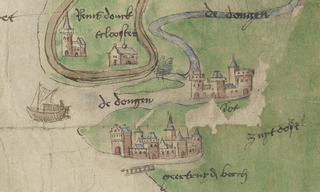
Margaret II of Avesnes was Countess of Hainaut and Countess of Holland from 1345 to 1356. She was Holy Roman Empress and Queen of Germany by marriage to Holy Roman Emperor Louis IV the Bavarian.

The Hook and Cod wars comprise a series of wars and battles in the County of Holland between 1350 and 1490. Most of these wars were fought over who should hold the title of "Count of Holland". The Cod faction generally consisted of the more progressive cities of Holland. The Hook faction consisted for a large part of the conservative noblemen.

Albert I, Duke of Lower Bavaria, was a feudal ruler of the counties of Holland, Hainaut, and Zeeland in the Low Countries. Additionally, he held a portion of the Bavarian province of Straubing, his Bavarian ducal line's appanage and seat, Lower Bavaria.

William I, Duke of Bavaria-Straubing, was the second son of Emperor Louis IV and Margaret II of Hainaut. He was also known as William V, Count of Holland, as William III, Count of Hainaut and as William IV, Count of Zeeland.

Dirk III van Brederode was lord of Brederode.

John I, Lord of Egmond was Lord of Egmond, Lord of IJsselstein, bailiff of Kennemerland (1353–1354) and stadtholder of Holland.

John II, Lord of Polanen was Lord of Polanen, Lord of De Lek and Lord of Breda.

John IV, Lord of Arkel was Lord of Arkel from 1326 until his death.

The Cod Alliance Treaty was a 1350 or 1351 treaty by which a number of nobles and cities allied with William V of Holland against his mother Margaret II, Countess of Hainaut and her allies. It was signed in the first phase of the Hook and Cod wars.

The Hook Alliance Treaty was signed during the first phase of the Hook and Cod wars in the County of Holland. By this treaty the Hook faction promised to support Margaret II, Countess of Hainaut against her rebellious son William of Bavaria.

The Battle of Veere was a small naval battle that took place in late May 1351 during the Hook and Cod wars.

Dirk III van Wassenaar was Heer van Wassenaar and burggraaf (burgrave) of Leiden.

Machteld van Voorne was Lady of Voorne, Monschau and Valkenburg, and burgrave of Zeeland. During the Hook and Cod wars she was an important ally of Count William V of Holland.

Wolfert III van Borselen was Lord of Veere and Zandenburg.

Jan II van Haamstede was lord of Haamstede and Haamstede Castle.

Nicolas, Claes or Klaas van Borselen was a younger son of Wolfert I van Borselen. He founded the Van Borselen branch later known as Van Brigdamme.

Floris I van BorselenFlorens de Bersalia was lord of Sint-Maartensdijk and Sint-Maartensdijk Castle, the count's lieutenant in Zeeland and keeper of the seal of Holland.

Geertruidenberg Castle was a major medieval castle in Geertruidenberg, then part of County of Holland now in North-Brabant, Netherlands
The siege of Geertruidenberg (1351–1352) was a long siege of Geertruidenberg Castle during the first of the Hook and Cod wars.

The siege of Zierikzee (1351) took place during the first of the Hook and Cod wars.



















